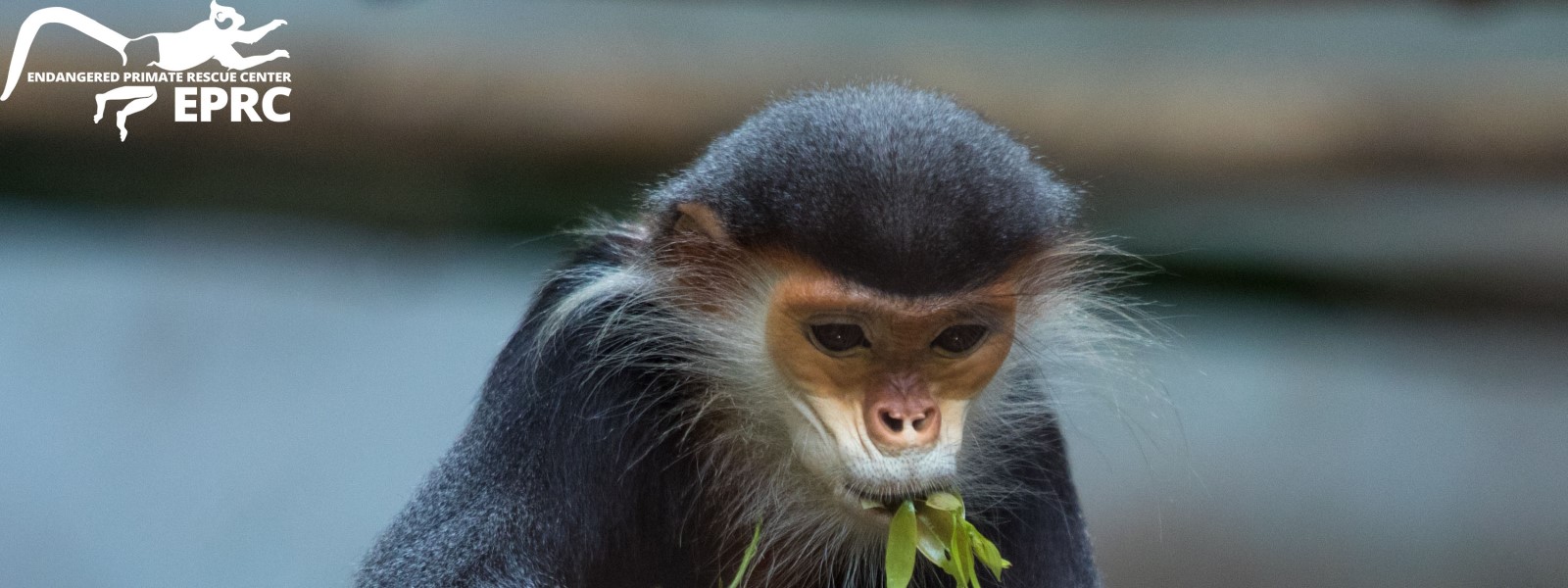Conservation Actions
This species is listed on CITES Appendix I.
In Viet Nam, the species is legally protected under Appendix 1B of Decree 32 (2006) and Appendix I of Decree 160 (2013).
In Lao PDR, the species is legally protected under the ‘Prohibited’ category of the list of threatened species, and the Wildlife and Aquatic Law (2007).
In Cambodia, the species is protected under the Cambodian Forestry Law under which it is listed as “Rare” (2002).
Red-shanked Douc is found in a number of National Protected Areas across its range, but unless there is international involvement in conservation efforts, NPAs are typically poorly managed. Those with ongoing conservation efforts where P. nemaeus occurs (as of 2015) include:
- In Lao PDR: Nakai-Nam Theun NPA; Hin Namno NPA; Laving–Laveun NPA; corridors between Xe Pian-Dong Ampham and Dong Ampham-Xe Sap NPAs; Xe Sap NPA; Koung Xe Nongma Provincial Protected Area. Many others with records from the 1990s have not received appropriate subsequent survey, but it would be rash to assume the species persists in all such areas. Nonetheless, it has probably not yet been eradicated from all of them.
- In Viet Nam: two Saola Nature Reserves; Bach Ma NP; Son Tra NR; Phong Nha Ke Bang NP; Chu Mom Ray NP; Phong Dien NR, Dak Rong NR.
- In Cambodia: Virachey NP.
Conservation organizations specifically focussing on the study and/or conservation of the species are: Project Anoulak in Nakai-Nam Theun NPA, Lao PDR (www.conservationlaos.com), Southern Institute of Ecology (SIE) in Son Tra NR Viet Nam, GreenViet in Son Tra NP, Viet Nam (http://en.greenviet.org/), The Douc Langur Foundation (http://douclangur.org/) in Viet Nam, Endangered Primate Rescue Centre (captive population), Viet Nam.
Location Information
This species occurs in eastern Lao PDR, central Viet Nam and, perhaps northeastern Cambodia. In Viet Nam Red-shanked Douc ranges from Pu Mat National Park (NP) (19°02’N) in the north to Chu Mom Ray NP (14°22’N) in the south (Ha Thang Long 2007, 2009). In Lao PDR, the species has been confirmed from Phou Chomvoy Provincial Protected Area (formerly known as Nam Theun Extension; 18°38’N), down to the Cambodian border (14°25’N) (Coudrat et al. 2012). In Cambodia, a few individuals were first observed in 2007 (at N14°01’52.2”, E106°44’05.6”) and again in 2008 (at N14°01’32.4”, E106°42’51.9”) in Voensei District, Ratanakiri Province. The individuals observed showed some facial characteristics of Red-shanked Douc, but were otherwise not typical of Red-shanked Douc morphologically (e.g., lacking red on the legs, lacking white on the forearms, mostly uniformly grey body but with some variations observed between individuals); some DNA (mitochondrial, autosomal and sex chromosome fragments) was extracted from faecal samples collected following the 2007-sighting, which indicated closest similarity to Red-shanked Douc (Rawson and Roos 2008). There has not been new genetic analysis on a larger sample since. Across its range, the species’ typical pelage characteristics are somewhat lost gradually from north to south: in southern Lao PDR, some individuals have also been observed with reduced red on the legs and white on the forearms (Timmins and Duckworth 1999). Additional genetic analysis on these animals will be required to clarify morphological characteristics of Red-shanked Douc and the distribution range of the species. Grey-shanked Douc might occur sympatrically with Red-shanked Douc in the southernmost part of the range of Red-shanked Douc. Previous suggestion that Black-shanked Douc occurs in the same site as Red-shanked Douc in northeastern Cambodia was in error (Rawson 2010; B. Rawson pers. comm. 2015).
The species has been recorded from around sea level to 1,700 m asl (Lippold 1998; Coudrat et al. 2012; Ulibarri 2013). Given patterns of survey, it is possible that it occurs, or occurred in the recent past, to altitudes considerably above 1,700 m.
Geographic Range
Extant
Cambodia, Lao People's Democratic Republic, Viet Nam
Population Information
The world’s largest remaining population of Red-shanked Douc Langur is in Lao PDR, particularly in the near-contiguous Nakai-Nam Theun and Hin Namno National Protected Areas (NPA), which are likely to represent the largest contiguous suitable habitat for the species (Coudrat et al. 2012, 2013). Nakai-Nam Theun NPA probably holds the world’s largest population with an estimate of at least 4,500 groups in the area’s suitable habitat, estimated to comprise at least 1,600 km². Red-shanked Doucs are fairly frequently encountered in this area, although nowadays at lower rates than langurs Trachypithecus in Hin Namno NPA (Phiapalath 2009, Coudrat 2015); in the late 1990s rates were comparable between the genera (Timmins and Duckworth 1999). Xe Sap NPA also appears to retain a significant population (Coudrat et al. 2012, Gray et al. 2013). The most remote suitable forested areas in Lao PDR within the species’ range evidently still hold large numbers, but population estimates are not available for most areas. Despite the remaining large population in Lao PDR, the population in the past three decades has dramatically declined.
In Viet Nam, the population has declined extremely steeply due to intensive and continuous hunting and habitat loss; these threats are still ongoing and at an increasing rate. Many areas where doucs were recorded during the 1990s to 2002 lack evidence of their subsequent persistence (Nadler 2010). Wildlife surveys found <30 individuals in Bach Ma NP (Le Thi Dien et al. 2010), about 30-70 individuals in Dak Rong NR (Nguyen Dac Manh et al. 2009, Dang Huy Huynh and Nguyen Manh Ha 2005) and a few groups (not comprehensive survey of the area) in Bac Huong Hoa NR (Mahood and Tran Van Hung 2008). The largest population in Viet Nam is believed to be in Phong Nha Ke Bang with up to 2,000 individuals (Haus et al. 2009), though this may be an over estimate (Nadler 2010). Son Tra NP, located near Da Nang, the fifth largest city of Viet Nam, is thought to hold the second largest population in Viet Nam. This is estimated at only about 200 individuals (Vu Ngoc Thanh et al. 2007; Lippold and Vu Ngoc Thanh 2008; Dinh Thi Phuong Anh et al. 2010). At this site, suitable habitat is no more than 50 km², amid a zone of large-scale infrastructure development, and hunting occurs occasionally in the area. Chu Mom Ray NP may still hold a small population, representing a possible zone of sympatry and/or hybridization, but the taxonomic status of the species there is uncertain (Lippold et al. 2011). Outside protected areas in Viet Nam, some small populations were recorded in the buffer zone of Phong Dien NR and Bach Ma NP (Van Ngoc Thinh et al. 2006).
In Cambodia, animals genetically identifiable as Red-shanked Douc, but not morphologically typical, occur in Virachay National Park and a forest area in Voensai District. In both these areas the population is considered large based on frequent encounters (Rawson 2010). Grey-shanked Douc may also range in at least part of these areas, and hybridization has been recorded (Rawson and Roos 2008).
Threats
Hunting has been and still is the major threat to Pygathrix nemaeus across its range. Habitat loss has also been a major threat in Viet Nam with extensive logging for coffee, rubber, and cashew plantations (Nadler et al. 2004), and in Lao PDR where logging is underway at an increasing rate for mining, agriculture, forestry and hydropower projects, mostly by large Chinese and Vietnamese companies (Smirnov 2015). Habitat loss and fragmentation have led to an increase in access to remote forests for illegal hunting of the species, contributing to the alarming declines of the global population. Hunting of the species across its range is for local consumption (the meat of doucs is highly favoured by locals) or for national and/or international trade. Pet trade in Red-shanked Douc may also drive hunting (Tran Thu Hang 2010), though to a lesser extent and is likely to be more opportunistic than directed, occurring when adults are killed leaving behind orphans, which are sold as pets. In Lao PDR, the species is hunted by both Lao and Vietnamese poachers crossing the border. Lao hunters often sell poached doucs to Vietnamese. Doucs are highly valued in Viet Nam for the traditional medicine; bones are processed to make a paste, which is used for the ‘treatment’ of various ailments. Due to hunting, Red-shanked Douc has already been largely extirpated throughout Viet Nam with the exceptions of populations in Phong Nha Ke Bang NP, where the species is apparently naturally protected by the difficult accessibility of this karst-based forest habitat, at least in its most remote sites, and in Son Tra NP where, although suitable forest for the species is now very limited, hunting seems under control and the species attracts a significant number of national and international tourists (Ha Thang Long pers. comm. 2015). In Virachey NP, illegal poaching occurs and doucs are hunted, most likely by Vietnamese poachers (G. McCann pers. comm. 2016). As douc populations are decreasing at an alarming rate, the hunting pressure on the species is expected to rise rapidly in all remaining areas where it occurs.
By the mid-to-late 1990s, Red-shanked Douc populations in several areas in Lao PDR and Viet Nam had already been greatly reduced or totally extirpated despite remaining suitable habitat (Timmins and Duckworth 1999; Nadler et al. 2003). This decline has been continuous and is likely to be increasing with the demand and lucrative trade in wildlife including specifically Doucs. Populations in Viet Nam alone have decreased to just a few individuals left in most localities of occurrence (Nadler 2010). In Lao PDR, several sites that were visited in the mid-1990s and then again in the 2000s and 2010s suggest a surprising decline in Red-shanked Doucs (Coudrat et al. 2012; Gray et al. 2013) The still large and healthy population of Red-shanked Doucs are now confined to the largest forest blocks in the range countries (Phiaphalath 2009, Coudrat et al. 2013). However, in the past 36 years (and much less) habitat loss in range countries has been on the rise due to large development projects (e.g., dams, roads, mining, agriculture plantations) (Smirnov 2015); therefore those contiguous forest blocks—even protected areas—are much more extensively accessed today than in the recent past, which predicts a continuing decline in Red-shanked Doucs due to harvesting, principally in those areas with a lack of or poor conservation management; one or other of these situations applies to all protected areas holding the species.
IUCN Red List Account Link
Please click here to see the species' IUCN Red List Account page.Photo Credits
Thumbnail: Chris Schuman / Endangered Primate Rescue Centre
Featured image: Ian Rock / Endangered Primate Rescue Centre





